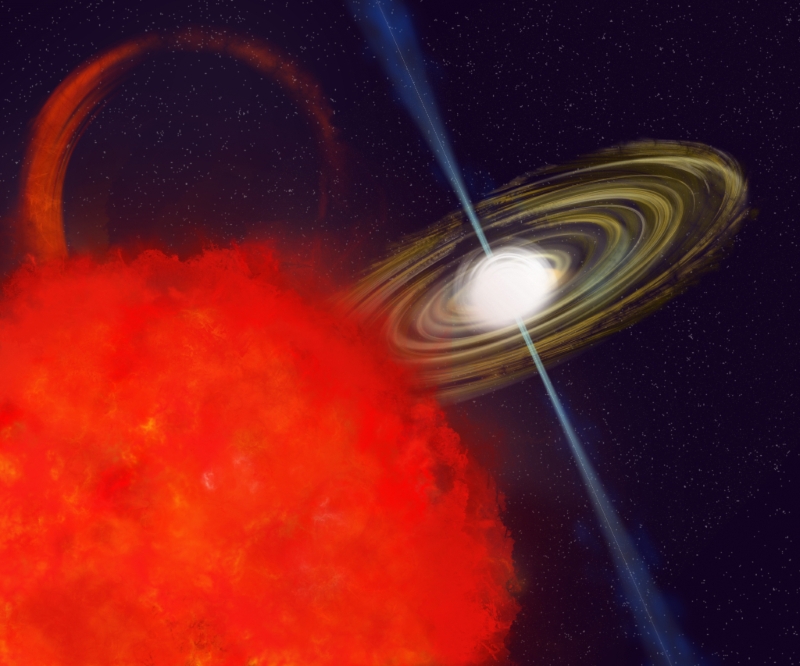The National Radio Astronomy Observatory published this original post on July 17, 2025. Edits by EarthSky.
Spinning ‘unicorn’ long-period radio transient defies astrophysics
Using some of the world’s most advanced radio telescopes, astronomers have discovered a bizarre, theory-defying object. Named CHIME J1634+44, it’s what scientists call a long-period radio transient: a source of radio emissions that repeat at long intervals, from minutes to hours. And, strangely, the signals from this long-period radio transient are speeding up. That’s a phenomenon never seen before in this class of astronomical objects.
Plus, the radio waves from CHIME J1634+44 are 100% circularly polarized, meaning they twist in a perfect spiral as they travel. That makes this object one of the most polarized long-period radio transients ever discovered. CHIME J1634+44’s unique properties challenge the current scientific understanding of how these objects work, and raise new questions about what they can teach us about the universe.
A cosmic ‘unicorn’
In light of this object’s strange properties, study lead Fengqiu Adam Dong said:
You could call CHIME J1634+44 a ‘unicorn’, even among other long-period radio transients.
Despite hundreds of detections across multiple observatories, the timing of the repeating radio bursts from CHIME J1634+44 is unclear. Dong said:
The bursts seem to repeat either every 14 minutes, or 841 seconds. But there is a distinct secondary period of 4206 seconds, or 70 minutes, which is exactly five times longer. We think both are real, and this is likely a system with something orbiting a neutron star.
Is this long-period radio transient 1 object or 2?
Normally, objects like neutron stars or white dwarfs slow down over time because they lose energy, so their spin period (time to complete a rotation) gets longer. But for CHIME J1634+44, the spin period is actually getting shorter, meaning its rotation is speeding up.
The only way to make the timing of the bursts fit together is to assume this speeding up is real. But, the researchers say, that’s unlikely if this is a lone star. Therefore, they believe that CHIME J1634+44 might actually be two stars orbiting each other very closely.
If the orbit of this binary system is shrinking – perhaps because they are losing energy by emitting gravitational waves or interacting with each other – it could make it look like the spin period is getting shorter. This kind of shrinking orbit has been seen in other close pairs of white dwarfs.
So is CHIME J1634+44 a pair of white dwarfs, or even a pair of neutron stars? If so, it’s acting unlike any of these objects we’ve studied before. The radio bursts from CHIME J1634+44 are 100% circularly polarized, meaning the radio waves twist in a perfect spiral as they travel. This is extremely rare, and no known white dwarf or neutron star has ever been seen to do this for every burst. The way these radio waves are being produced appears to be different from what we’ve seen in any other known object.
Dong said:
The discovery of CHIME J1634+44 expands the known population of long-period radio transients and challenges existing models of neutron stars and white dwarfs, suggesting there may be many more such objects awaiting discovery.
A collaborative success
The unparalleled collection of telescopes used in this research allowed scientists to detect and study the object’s unusual signals in detail.
The Canadian Hydrogen Intensity Mapping Experiment’s (CHIME) wide field of view and daily sky scans detected the transient’s periodic bursts and monitored its spin evolution.
The National Science Foundation’s Very Large Array (VLA), supported by realfast (a system for real-time fast transient searches), provided high-frequency follow-up observations to mitigate interstellar medium distortions and refine localization.
The National Science Foundation’s Green Bank Telescope (GBT) contributed sensitive, high-resolution timing data to analyze polarization and spin-up behavior, enhancing precision for gravitational wave studies.
NASA’s Neil Gehrels Swift Observatory searched for X-ray counterparts, and its multi-wavelength capabilities allowed the researchers to probe for high-energy signals that complemented radio observations.
Bottom line: Astronomers have discovered a long-period radio transient with bizarre, theory-defying properties. It’s incredibly polarized, and its spin appears to be speeding up.
Via NRAO
Read more: Unusual star pulsing in X-ray and radio baffles scientists
